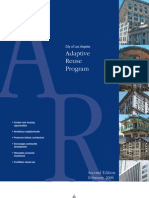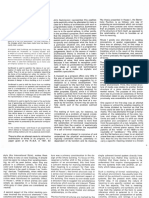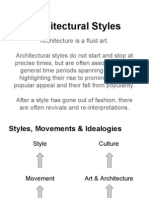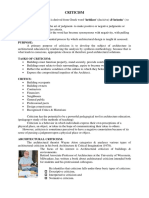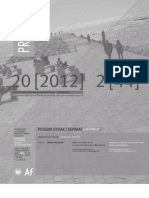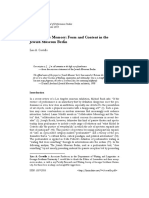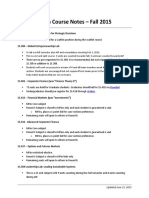Architectural Theory
Architectural Theory
Uploaded by
Dorian VujnovićCopyright:
Available Formats
Architectural Theory
Architectural Theory
Uploaded by
Dorian VujnovićOriginal Description:
Copyright
Available Formats
Share this document
Did you find this document useful?
Is this content inappropriate?
Copyright:
Available Formats
Architectural Theory
Architectural Theory
Uploaded by
Dorian VujnovićCopyright:
Available Formats
Architectural theory
Architectural theory
Architectural theory is the act of thinking, discussing, and writing about architecture. Architectural theory is taught in most architecture schools and is practiced by the world's leading architects. Some forms that architecture theory takes are the lecture or dialogue, the treatise or book, and the paper project or competition entry. Architectural theory is often didactic, and theorists tend to stay close to or work from within schools. It has existed in some form since antiquity, and as publishing became more common, architectural theory gained an increased richness. Books, magazines, and journals published an unprecedented amount of works by architects and critics in the 20th century. As a result, styles and movements formed and dissolved much more quickly than the relatively enduring modes in earlier history. It is to be expected that the use of the internet will further the discourse on architecture in the 21st century.
Architectural discourse from the illustrated French Dictionary of Architecture (1856) by Eugne Viollet-le-Duc
History
Antiquity
There is little information or evidence about major architectural theory in antiquity, until the 1st century BCE, with the work of Vitruvius. This does not mean, however, that such works did not exist. Many works never survived antiquity, and the burning of the Alexandria Library shows us a very good example of this. Vitruvius was a Roman writer, architect, and engineer active in the 1st century BCE. He was the most prominent architectural theorist in the Roman Empire known today, having written De architectura, (known today as The Ten Books of Architecture), a treatise written of Latin and Greek on architecture, dedicated to the emperor Augustus. Probably written between 27 and 23 BCE,[1] it is the only major contemporary source on classical architecture to have survived. Divided into ten sections or "books", it covers almost every aspect of Roman architecture, from town planning, materials, decorations, temples, water supplies, etc. It rigorously defines the classical orders of architecture. It also proposes the three fundamental laws that Architecture must obey, in order to be so considered: firmitas, utilitas, venustas, translated in the 17th century by Sir Henry Wotton into the English slogan firmness, commodity and delight (meaning structural adequacy, functional adequacy, and beauty). The rediscovery of Vitruvius' work had a profound influence on architects of the Renaissance, adding archaeological underpinnings to the rise of the Renaissance style, which was already under way. Renaissance architects, such as Niccoli, Brunelleschi and Leon Battista Alberti, found in "De Architectura" their rationale for raising their branch of knowledge to a scientific discipline.
Middle Ages
Throughout the Middle Ages, architectural knowledge was passed by transcription, word of mouth and technically in master builders' lodges.[2] Due to the laborious nature of transcription, few examples of architectural theory were penned in this time period. Most works that from this period were theological, and were transcriptions of the bible, so the architectural theories were the notes on structures included therein. The Abbot Suger's Liber de rebus in administratione sua gestis, was an architectural document that emerged with gothic architecture. Another was Villard de Honnecourt's portfolio of drawings from about the 1230s.
Architectural theory In Song Dynasty China, Li Jie published the Yingzao Fashi in 1103, which was an architectural treatise that codified elements of Chinese architecture.[3][4]
Renaissance
The first great work of architectural theory of this period belongs to Leon Battista Alberti, De Re Aedificatoria, which placed Vitruvius at the core of the most profound theoretical tradition of the modern ages. From Alberti, good architecture is validated through the Vitruvian triad, which defines its purpose. This triplet conserved all its validity until the 19th century. A major transition into the seventeenth century and ultimately to the phase of Enlightenment was secured through the advanced mathematical and optical research of the celebrated architect and geometer Girard Desargues, with an emphasis on his studies on perspective and projective geometry.
Enlightenment
The Age of the Enlightenment witnessed considerable development in architectural theory on the European continent. New archeological discoveries (such as those of Pompeii and Herculaneum) drove new interest in Classical art and architecture. Thus the term Neoclassicism (exemplified by the writings of Prussian art critic Johann Joachim Winkelmann) arose to designate 18th-century architecture which looked to these new Classical precedents for inspiration in building design.[5] Major architectural theorists of the Enlightenment include Julien-David Leroy, Abb Marc-Antoine Laugier, Giovanni Battista Piranesi, Robert Adam, James Stuart, Georg Friedrich Hegel[6] and Nicholas Revett.
Nineteenth century
A vibrant strain of Neoclassicism, inherited from Marc-Antoine Laugier's seminal Essai, provided the foundation for two generations of international activity around the core themes of classicism, primitivism and a "return to Nature." Reaction against the dominance of neo-classical architecture came to the fore in the 1820s with Augustus Pugin providing a moral and theoretical basis for Gothic Revival architecture, and in the 1840s John Ruskin developed this ethos. The American sculptor Horatio Greenough published the essay American Architecture in August 1843 in which he rejected the imitation of old styles of buildings and outlined the functional relationship between architecture and decoration. These theories anticipated the development of Functionalism in modern architecture. Towards the end of the century, there occurred a blossoming of theoretical activity. In England, Ruskin's ideals underpinned the emergence of the Arts and Crafts movement exemplified by the writings of William Morris. This in turn formed the basis for Art Nouveau in the UK, exemplified by the work of Charles Rennie Mackintosh, and influenced the Vienna Secession. On the Continent, the theories of Viollet-le-Duc and Gottfried Semper provided the springboard for enormous vitality of thought dedicated to architectural innovation and the renovation of the notion of style. Semper in particular developed an international following, in Germany, England, Switzerland, Austria, Bohemia, France, Italy and the United States. The generation born during the middle-third of the 19th century was largely enthralled with the opportunities presented by Semper's combination of a breathtaking historical scope and a methodological granularity. In contrast to more recent, and thus "modern", thematically self-organized theoretical activities, this generation did not coalesce into a "movement." They did, however, seem to converge on Semper's use of the concept of Realismus, and they are thus labelled proponents of architectural realism. Among the most active Architectural Realists were: Georg Heuser, Rudolf Redtenbacher, Constantin Lipsius, Hans Auer, Paul Sdille, Lawrence Harvey, Otto Wagner and Richard Streiter.
Architectural theory
Twentieth century
In 1889 Camillo Sitte published Der Stdtebau nach seinem knstlerischen Grundstzen (translated as City Planning According to Artistic Principles) which was not exactly a criticism of architectural form but an aesthetic criticism (inspired by medieval and Baroque town planning) of 19th century urbanism. Mainly a theoretical work, it had an immediate impact on architecture, as the two disciplines of architecture and planning intertwined. Demand for it was so high that five editions appeared in German between 1889 and 1922 and a French translation came out in 1902. (No English edition came out until 1945.) For Sitte, the most important issue was not the architectural shape or form of a building but the quality of the urban spaces that buildings collectively enclose, the whole being more than the sum of its parts. The Modern Movement rejected these thoughts and Le Corbusier energetically dismissed the work. Nevertheless, Sitte's work was revisited by post-modern architects and theorists from the 1970s, especially following its republication in 1986 by Rizzoli, in an edition edited by Collins and Collins (now published by Dover). The book is often cited anachronistically today as a vehicle for the criticism of the Modern Movement. Also on the topic of artistic notions with regard to urbanism was Louis Sullivan's The Tall Office Building Artistically Considered of 1896.[7] In this essay, Sullivan penned his famous alliterative adage "form ever follows function"; a phrase that was to be later adopted as a central tenet of Modern architectural theory. While later architects adopted the abbreviated phrase "form follows function" as a polemic in service of functionalist doctrine, Sullivan wrote of function with regard to biological functions of the natural order. Another influential planning theorist of this time was Ebenezer Howard, who founded the garden city movement. This movement aimed to form communities with architecture in the Arts and Crafts style at Letchworth and Welwyn Garden City and popularised the style as domestic architecture. In Vienna, the idea of a radically new modern architecture had many theorists and proponents. An early use of the term modern architecture in print occurred in the title of a book by Otto Wagner,[8][9] who gave examples of his own work representative of the Vienna Secession with art nouveau illustrations, and didactic teachings to his students. Soon thereafter, Adolf Loos wrote Ornament and Crime, and while his own style is usually seen in the context of the Jugendstil, his demand for "the elimination of ornament" joined the slogan "form follows function" as a principle of the architectural so-called Modern Movement that came to dominate the mid-20th Century. Walter Gropius, Ludwig Mies van der Rohe and Le Corbusier provided the theoretical basis for the International Style with aims of using industrialised architecture to reshape society. Frank Lloyd Wright, while modern in rejecting historic revivalism, was idiosyncratic in his theory, which he conveyed in copious writing. Wright did not subscribe to the tenets of the International Style, but evolved what he hoped would be an American, in contrast to a European, progressive course. Wright's style, however, was highly personal, involving his particular views of man and nature. Wright was more poetic and firmly maintained the 19th century view of the creative artist as unique genius. This limited the relevance of his theoretical propositions. Towards the end of the century postmodern architecture reacted against the austerity of High Modern (International Style) principles, viewed as narrowly normative and doctrinaire.
Contemporary
In contemporary architectural discourse theory has become more concerned with its position within culture generally, and thought in particular. This is why university courses on architecture theory may often spend just as much time discussing philosophy and cultural studies as buildings, and why advanced postgraduate research and doctoral dissertations focus on philosophical topics in connection with architectural humanities. Some architectural theorists aim at discussing philosophical themes, or engage in direct dialogues with philosophers, as in the case of Peter Eisenman's interest in Derrida's thought, or Christian Norberg-Schulz's interest in the works of Heidegger. This has also been the case with educators in academia like Dalibor Vesely or Alberto-Perez Gomez, and in more recent years this philosophical orientation has been reinforced through the research of a new generation of younger theorists, such as the philosopher-architect Nader El-Bizri or the academic-architect Adam Sharr. Similarly, we can refer to contemporary architects who are interested in phenomenology, like Steven Holl, Peter Zumthor and Juhani
Architectural theory Pallasmaa, and who are referred to as "phenomenologists". The notion that theory entailed critique also stemmed from post-structural literary studies. This, however, pushed architecture towards the notion of avant-gardism for its own sake - in many ways repeating the 19th century art for art's sake outlook. Since 2000 this has materialised in architecture through concerns with the rapid rise of urbanism and globalization, but also a pragmatic understanding that the city can no longer be a homogeneous totality. Interests in fragmentation and architecture as transient objects further affected such thinking (e.g. the concern for employing high technology) but also related to general concerns such as ecology, mass media, and economism. In the past decade, there has been a resurgence of proto-Modern "organic design" theories, but in a supposedly more scientific setting. Several currents and design methodologies are being developed simultaneously, some of which reinforce each other whereas others work in opposition. One of these trends is Biomimicry, which is the process of examining nature, its models, systems, processes, and elements to emulate or take inspiration from in order to solve human problems.[10] Architects also design organic-looking buildings in the belief that by copying nature, Organic architecture reaches a more attractive or (more frequently) more efficient form. Another trend is the exploration of those computational techniques that are influenced by algorithms relevant to biological processes and sometimes referred to as Digital morphogenesis. Trying to utilize Computational creativity in architecture, Genetic algorithms developed in computer science are applied to evolve designs on a computer, and some of these are proposed and built as actual structures. There exists, however, a controversy as to whether all such evolved designs through Design computing are truly appropriate for buildings or are instruments of self-deception dependent on the misapplication of biological analogies and metaphors. The new discipline of biophilia developed by E. O. Wilson suggests the advantages of forms inspired by biological structures, but in a more profound way than simple mimicry. Wilson's original idea is extended by Stephen R. Kellert in the Biophilia hypothesis, and applied to architectural design in the book "Biophilic Design". Mathematical features of biological forms such as fractals, Scale-invariance, very sophisticated notions of symmetry, Self-similarity, and complex Hierarchy are proposed as essential tools for designing architectural forms. Trying to understand the complex interaction between humans and their environment gained from Human-computer interaction, Mobile robotics, and Artificial intelligence leads to ideas in Intelligence-Based Design. All these developments, though minuscule and highly localised in terms of total architectural output, give some observers (notably Harry Francis Mallgrave of the College of Archtitecture at IIT) evidence for claiming that we are witnessing the birth of an entirely new type of architectural theory bearing little resemblance to the dominant school of architectural theory based on linguistic analysis, philosophy, post-structuralism, or cultural theory. It is too early, however, to say whether any of these explorations will have widespread or lasting impact.
Architectural theory
Some architectural theorists
Historical Vitruvius Leon Battista Alberti Andrea Palladio Sebastiano Serlio Grard Desargues John Ruskin Horatio Greenough Eugne Viollet-le-Duc Karl Friedrich Schinkel Gottfried Semper Hans Auer Paul Sdille Hermann Muthesius Modernist Bruno Zevi Leonardo Benevolo Steen Eiler Rasmussen Otto Wagner Le Corbusier Adolf Loos Raymond Unwin Ebenezer Howard Christian Norberg-Schulz Rudolf Arnheim Lcio Costa Contemporary Kenneth Frampton Christopher Alexander Stan Allen K. Michael Hays Oswald Mathias Ungers Rem Koolhaas Leon Krier Sanford Kwinter Dalibor Vesely David Leatherbarrow Nader El-Bizri Alberto Prez-Gmez Joseph Rykwert Marco Frascari Robert Tavernor Daniel Libeskind Juhani Pallasmaa Colin Rowe Werner Oechslin (see German Wikipedia) Richard Sennett Nikos Salingaros Bernard Tschumi Andrea Branzi Robert Somol Peter Cook (architect)
Postmodernist Charles Jencks Aldo Rossi Peter Eisenman Robert Venturi
Notes
[1] Kruft, p.447. [2] Evers, Thoenes, et al., p.13. [3] Liang Ssu-ch'eng. A Pictorial History of Chinese Architecture: a Study of the Development of its Structural System and the Evolution of its Types. MIT press, 1984. ISBN 0-262-12103-4 [4] Nancy Shatzman Steinhardt ed. Chinese Architecture. Yale University Press, 2002. ISBN 0-300-09559-7 [5] Robin Middleton and David Watkin, Neoclassicism and 19th-Century Architecture. The MIT Press, 1980 and Barry Bergdoll, European Architecture 17501890, Oxford University Press, 2000.l, [6] Mark Jarzombek, * "The Cunning of Architecture's Reason," (http:/ / web. mit. edu/ mmj4/ www/ downloads/ footprint1. pdf) Footprint (#1, Autumn 2007), pp. 31-46. [7] Louis H. Sullivan. Kindergarten Chats and Other Writings. Courier Dover Publications, 1979. Page 202. ISBN 0-486-23812-1 [8] Otto Wagner. Moderne Architektur: Seinen Schlern ein Fhrer auf diesem Kunstgebiete. (http:/ / books. google. com/ books?id=AvgjAAAAMAAJ& pg=PA2& dq) Anton Schroll. 1902. [9] Otto Wagner. Translated by Harry Francis Mallgrave. Modern Architecture: A Guidebook for His Students to This Field of Art. Getty Center for the History of Art and the Humanities. 1988. ISBN 0-226-86938-5 [10] Reading University: What is Biomimetics? (http:/ / www. reading. ac. uk/ biomimetics/ about. htm) Retrieved 3 June 2012.
Architectural theory
References
Reyner Banham. Theory and Design in the First Machine Age. Praeger Publishers, 1960. ISBN 0-262-52058-3 Bernd Evers, Christoph Thoenes, et al. Architectural Theory from the Renaissance to the Present. Taschen, 2003. ISBN 3-8228-1699-X K. Michael Hays. Architecture Theory since 1968. Cambridge: MIT Press, 1998. ISBN 0-262-58188-4 Mark Jarzombek, "The Cunning of Architecture's Reason," (http://web.mit.edu/mmj4/www/downloads/ footprint1.pdf) Footprint (#1, Autumn 2007), pp.3146. Stephen R. Kellert, Judith Heerwagen, and Martin Mador, Editors, "Biophilic Design: the Theory, Science, and Practice of Bringing Buildings to Life", John Wiley, New York, 2008. ISBN 978-0-470-16334-4 Hanno-Walter Kruft. A history of architectural theory: from Vitruvius to the present. Princeton Architectural Press, 1994. ISBN 1-56898-010-8 Harry F. Mallgrave, Modern Architectural Theory: A Historical Survey, 1673-1969. Cambridge University Press, 2005. ISBN 0-521-79306-8 Kate Nesbitt. Theorizing a New Agenda for Architecture: An Anthology of Architectural Theory. Princeton Architectural Press, 1996. ISBN 1-56898-054-X Joan Ockman, Edward Eigen. Architecture Culture 1943-1968: A Documentary Anthology. Rizzoli, 1993. ISBN 0-8478-1511-0 Nikos Salingaros. "A Theory of Architecture". Umbau-Verlag, 2006. ISBN 3-937954-07-4. Manfredo Tafuri, translated by Giorgio Verrecchia. Theories and History of Architecture. Harper & Row, 1968. ISBN 0-06-438580-9 Vitruvius, Translation: Morris Hicky Morgan (1960). The Ten Books On Architecture. Dover Publications.
Article Sources and Contributors
Article Sources and Contributors
Architectural theory Source: http://en.wikipedia.org/w/index.php?oldid=526527731 Contributors: Ablab123, ActivExpression, Aldux, Antandrus, AppliedIconology, Arkitektpt, ArnoldPlaton, Astosun, BD2412, Bjankuloski06en, Bons, Braincricket, Brent Burgoyne, Brosi, Cjs2111, Clicketyclack, CliffC, Colonies Chris, Cunners, D. Recorder, DVD R W, Dave souza, Dogears, Ecalpemos, Elekhh, Erebus555, Factdetectiveoline, Factfindersonline, F, GoingBatty, Graldensblud, Hasanisawi, Hmains, Hu12, I dream of horses, Jeff3000, Jim1138, Jkeene, Jncraton, John, JoyKnoblauch, Jpbowen, Kmichaelhays, Koavf, MapsMan, Mcginnly, Mmxiicybernaut, Nicke L, Nikos.salingaros, O0chris0o, Oikoumenikos, Phmalo, Psychomuffinsdm, Queen Of Spades, Rapporteursurligne, Rich Farmbrough, Ryulong, SchreiberBike, Stephen Games, Svea Kollavainen, TTKK, Visconti24, Wknight94, 58 anonymous edits
Image Sources, Licenses and Contributors
File:Architectes.medievaux.png Source: http://en.wikipedia.org/w/index.php?title=File:Architectes.medievaux.png License: Public Domain Contributors: Buzz, Gryffindor, Tvanhulzen, Wst, 1 anonymous edits
License
Creative Commons Attribution-Share Alike 3.0 Unported //creativecommons.org/licenses/by-sa/3.0/
You might also like
- Architectural Theory - Vol. IIDocument326 pagesArchitectural Theory - Vol. IIPaulo Aureliano da Mata100% (12)
- Solomon R. Guggenheim Museum: An Architectural AppreciationFrom EverandSolomon R. Guggenheim Museum: An Architectural AppreciationNo ratings yet
- Adaptive Reuse Book LADocument130 pagesAdaptive Reuse Book LAIoana Minciuna100% (3)
- History of Modern Architecture Class NotesDocument71 pagesHistory of Modern Architecture Class NotesIvan Litvinenko100% (1)
- Arch413 - Qualities of Architectural Space (Plus Space Analysis Matrix - Term Project)Document32 pagesArch413 - Qualities of Architectural Space (Plus Space Analysis Matrix - Term Project)arkiosk85% (33)
- Architectural Theory. An Anthology From Vitruvius To 1870. Vol IDocument616 pagesArchitectural Theory. An Anthology From Vitruvius To 1870. Vol ISanta María del Placer100% (3)
- On Architecture: Collected Reflections on a Century of ChangeFrom EverandOn Architecture: Collected Reflections on a Century of ChangeRating: 4.5 out of 5 stars4.5/5 (6)
- What Is Contemporary Architecture PDFDocument4 pagesWhat Is Contemporary Architecture PDFMaru PabloNo ratings yet
- Phenomena of Relations Steven HollDocument34 pagesPhenomena of Relations Steven HollFunda TanNo ratings yet
- Eisenman - House I: Cardboard Architecture (From Five Architects) PDFDocument9 pagesEisenman - House I: Cardboard Architecture (From Five Architects) PDFJames Lowder100% (2)
- Daoist MysticismDocument4 pagesDaoist MysticismMohammedFaizaanFaraz50% (4)
- Heinrich KlotzDocument469 pagesHeinrich KlotzBilly ChristovelNo ratings yet
- The Origins And Myths Of Modern ArchitectureFrom EverandThe Origins And Myths Of Modern ArchitectureRating: 4.5 out of 5 stars4.5/5 (3)
- Architectural Dissertation Handbook - PreviewDocument260 pagesArchitectural Dissertation Handbook - PreviewSwechcha50% (2)
- A City Is Not A TreeDocument9 pagesA City Is Not A TreesamuelioNo ratings yet
- Unlearning Architecture: Louis I. Kahn Graduate Studio and OfficeFrom EverandUnlearning Architecture: Louis I. Kahn Graduate Studio and OfficeNo ratings yet
- Oma Sustainability - Advancement Vs Apocalypse PDFDocument4 pagesOma Sustainability - Advancement Vs Apocalypse PDFDorian VujnovićNo ratings yet
- Continuity or Crisis? - Ernesto N. RogersDocument4 pagesContinuity or Crisis? - Ernesto N. RogersDorian VujnovićNo ratings yet
- The Impact of 3D Printing Technology On The Society and EconomyDocument11 pagesThe Impact of 3D Printing Technology On The Society and EconomyDorian VujnovićNo ratings yet
- Biometric Change FormDocument1 pageBiometric Change FormAgha Khan Durrani75% (8)
- FPC ManualDocument8 pagesFPC ManualAdnan KaraahmetovicNo ratings yet
- Theory of Architecture in History - 01Document41 pagesTheory of Architecture in History - 01Siva Raman80% (5)
- The 50 Greatest Architects: The People Whose Buildings Have Shaped Our WorldFrom EverandThe 50 Greatest Architects: The People Whose Buildings Have Shaped Our WorldNo ratings yet
- A Text-Book of the History of Architecture Seventh Edition, revisedFrom EverandA Text-Book of the History of Architecture Seventh Edition, revisedNo ratings yet
- TOA3 - Architectural TheoriesDocument116 pagesTOA3 - Architectural Theoriesarkiosk100% (2)
- The Seven Lamps of Architecture by John Ruskin PreviewDocument20 pagesThe Seven Lamps of Architecture by John Ruskin PreviewPat CoyneNo ratings yet
- The Integration of Contemporary Architecture in Heritage SitesFrom EverandThe Integration of Contemporary Architecture in Heritage SitesNo ratings yet
- Theory of ArchitectureDocument14 pagesTheory of Architecturemesmerizingstarlight100% (1)
- Architecture AestheticsDocument9 pagesArchitecture Aestheticsrb2166No ratings yet
- History of Architecture: Reference BooksDocument14 pagesHistory of Architecture: Reference BooksKimberly Anne PerezNo ratings yet
- Architectural Concepts and Their ManifestationDocument31 pagesArchitectural Concepts and Their ManifestationArdeleanu Mihai100% (1)
- Architectural Styles, Movements and IdeologiesDocument103 pagesArchitectural Styles, Movements and IdeologiesNancy Tess100% (4)
- Site AnalysisDocument105 pagesSite AnalysisSara TahirNo ratings yet
- Organic ArchitectureDocument4 pagesOrganic ArchitectureShubham Goenka67% (3)
- Carlo ScarpaDocument10 pagesCarlo ScarpaNeitherboth75% (4)
- Urban Space-Robert Schafer PDFDocument13 pagesUrban Space-Robert Schafer PDFgiljermoNo ratings yet
- How To Develop Architectural Concepts by First in ArchitectureDocument5 pagesHow To Develop Architectural Concepts by First in ArchitectureKaloy100% (1)
- 10 International Styel and Modernism (Introduction and History)Document158 pages10 International Styel and Modernism (Introduction and History)Dexiz BellenNo ratings yet
- MASTERS OF ARCHITECTURE OddDocument5 pagesMASTERS OF ARCHITECTURE OddTrina Sambas100% (1)
- Structuralism (Architecture)Document6 pagesStructuralism (Architecture)Irina Sandu100% (2)
- Architectural ConceptDocument54 pagesArchitectural Conceptazimkhtr@gmail.com100% (5)
- Pritzker Prize ArchitectsDocument56 pagesPritzker Prize ArchitectsShervin Peji100% (1)
- Unit-1 Theory of ArchitectureDocument43 pagesUnit-1 Theory of ArchitectureSiva Raman75% (4)
- The Covert Life of Hospital ArchitectureFrom EverandThe Covert Life of Hospital ArchitectureJulie ZookNo ratings yet
- BrutalismDocument6 pagesBrutalismLuka RomanovNo ratings yet
- Architectural ConceptsDocument40 pagesArchitectural ConceptsRose Celine Diaz100% (5)
- Purposeful ArchitectureDocument9 pagesPurposeful ArchitectureYesTaratNo ratings yet
- Architectural EbooksDocument5 pagesArchitectural EbooksShiena Beason0% (1)
- Elements of Architecture - Rob KrierDocument97 pagesElements of Architecture - Rob KrierIsopescu Laurentiu100% (18)
- The Beautiful Necessity: Essays on ArchitectureFrom EverandThe Beautiful Necessity: Essays on ArchitectureRating: 5 out of 5 stars5/5 (1)
- Basics Architectural DesignDocument7 pagesBasics Architectural DesignDipu GeorgeNo ratings yet
- Modern ArchitectureDocument5 pagesModern ArchitectureJireh GraceNo ratings yet
- Reyner Banham - A Throw-Away AestheticDocument4 pagesReyner Banham - A Throw-Away AestheticclaudiotriasNo ratings yet
- Phenomenology (Architecture)Document4 pagesPhenomenology (Architecture)Marcopó JuarezNo ratings yet
- The Influence of Le Corbusier On The Emergence of The Aesthetic Values in The Modern Architecture of CyprusDocument12 pagesThe Influence of Le Corbusier On The Emergence of The Aesthetic Values in The Modern Architecture of CyprusJournal of Contemporary Urban AffairsNo ratings yet
- Research Paper On Green ArchitectureDocument18 pagesResearch Paper On Green ArchitectureSheena Crisostomo Tuazon50% (2)
- Daniel LibeskindDocument38 pagesDaniel LibeskindSyed Imran100% (6)
- TWA - Sacred Architecture in A Secular CenturyDocument10 pagesTWA - Sacred Architecture in A Secular CenturyJohn JohnsonNo ratings yet
- Criticism: PurposeDocument6 pagesCriticism: PurposeTousif Shaikh100% (1)
- 4.2.1. The City Square - Quadralectic Architecture PDFDocument13 pages4.2.1. The City Square - Quadralectic Architecture PDFMarco PlebaniNo ratings yet
- Housing in Harbours in HollandDocument7 pagesHousing in Harbours in HollandDorian VujnovićNo ratings yet
- Wha Web PDF Local Heroes Celsing N Eng PDFDocument14 pagesWha Web PDF Local Heroes Celsing N Eng PDFDorian VujnovićNo ratings yet
- Typology and The Design Method - Colquhoun, AlanDocument4 pagesTypology and The Design Method - Colquhoun, AlanDorian VujnovićNo ratings yet
- AA Files, Goodbye Paper, Christophe Van GerreweyDocument18 pagesAA Files, Goodbye Paper, Christophe Van GerreweyDorian VujnovićNo ratings yet
- Arhitektonski Opus Lavoslava Horvata U BeograduDocument20 pagesArhitektonski Opus Lavoslava Horvata U BeograduDorian VujnovićNo ratings yet
- Life Transforms Living Transforms LifeDocument12 pagesLife Transforms Living Transforms LifeDorian VujnovićNo ratings yet
- In The Academy S Garden Robert Venturi T PDFDocument22 pagesIn The Academy S Garden Robert Venturi T PDFDorian VujnovićNo ratings yet
- The Early Chicago Tall Office Building: Artistically and Functionally ConsideredDocument9 pagesThe Early Chicago Tall Office Building: Artistically and Functionally ConsideredDorian VujnovićNo ratings yet
- Otto Wagner, Development of A Great CityDocument9 pagesOtto Wagner, Development of A Great CityDorian VujnovićNo ratings yet
- Markowsky&gd RatioDocument18 pagesMarkowsky&gd RatioanpietroNo ratings yet
- The Retreat From Autonomy: Post-Modernism As Generalised Conformism CORNELIUS CASTORIADISDocument11 pagesThe Retreat From Autonomy: Post-Modernism As Generalised Conformism CORNELIUS CASTORIADISDorian Vujnović100% (1)
- Performative Memory: Form and Content in The Jewish Museum BerlinDocument23 pagesPerformative Memory: Form and Content in The Jewish Museum BerlinDorian VujnovićNo ratings yet
- The Ecstacy of Communication - BaudrillardDocument5 pagesThe Ecstacy of Communication - BaudrillardMardawud JamiNo ratings yet
- THE LIVED METAPHOR by Juhani PallasmaaDocument2 pagesTHE LIVED METAPHOR by Juhani PallasmaaDorian VujnovićNo ratings yet
- Asia World Recruitment V NLRCDocument2 pagesAsia World Recruitment V NLRCBernadette FloresNo ratings yet
- DeSantis Pfizer Public Records RequestDocument2 pagesDeSantis Pfizer Public Records RequestDaniel UhlfelderNo ratings yet
- Automobile Industry in Myanmar: Dr. Soe Tun PresidentDocument35 pagesAutomobile Industry in Myanmar: Dr. Soe Tun PresidentTeddy KhantNo ratings yet
- Resourcing An OrganizationDocument15 pagesResourcing An OrganizationPhan Phu Truong (FGW HCM)No ratings yet
- 4 PDFDocument2 pages4 PDFomNo ratings yet
- NUR 352 Course SyllabusDocument9 pagesNUR 352 Course SyllabusYumnaNo ratings yet
- MIT Course ReviewDocument6 pagesMIT Course ReviewDiego VegaNo ratings yet
- Harris 2020 Language and Literacy LearningDocument35 pagesHarris 2020 Language and Literacy Learning李文滔No ratings yet
- Chen Wei A Paper Tiger Credit Hire NewsletterDocument8 pagesChen Wei A Paper Tiger Credit Hire NewsletterHogiwanNo ratings yet
- Verso Do Awb - ContratoDocument1 pageVerso Do Awb - ContratoMarouza HainanNo ratings yet
- Mindfulness AssignmentDocument2 pagesMindfulness AssignmentAditya HonguntiNo ratings yet
- Poetry in P and IsDocument9 pagesPoetry in P and IsAbeer ANo ratings yet
- Audio Lingual MethodDocument1 pageAudio Lingual MethodSandro CandelitaNo ratings yet
- Maninang Documentationandcommunicationplan JBDocument11 pagesManinang Documentationandcommunicationplan JBapi-549335560No ratings yet
- Case Analysis ShampooDocument6 pagesCase Analysis ShampooMEDISHETTY MANICHANDANANo ratings yet
- Barangay Peacekeeping Action Team and Barangay Peacekeeping Operations ManualDocument35 pagesBarangay Peacekeeping Action Team and Barangay Peacekeeping Operations ManualJustin SnNo ratings yet
- Evidence Notes - Interpretation of DocumentsDocument8 pagesEvidence Notes - Interpretation of DocumentsRobehgene Atud-JavinarNo ratings yet
- Labour Law1Document2 pagesLabour Law1Mustaq AhmedNo ratings yet
- EyeforTravel - The Travel Leadership Forum: Evolution of Online Travel 2008Document6 pagesEyeforTravel - The Travel Leadership Forum: Evolution of Online Travel 2008Nikhil VijayanNo ratings yet
- Practical ResearchDocument42 pagesPractical ResearchMilly RuizNo ratings yet
- Resume For Ecomp-2Document2 pagesResume For Ecomp-2Daille Wroble GrayNo ratings yet
- 2018 - Digitalization of Human ResourcesDocument108 pages2018 - Digitalization of Human ResourcesRoxana Mihaela100% (1)
- CV NadaaminDocument2 pagesCV Nadaaminnada aminNo ratings yet
- Apqp REV01Document152 pagesApqp REV01MURALIDHRA100% (1)
- On The Way To Decolonization in A Settler Colony: Re-Introducing Black Feminist Identity PoliticsDocument10 pagesOn The Way To Decolonization in A Settler Colony: Re-Introducing Black Feminist Identity PoliticskiiNo ratings yet
- An Overview of Models of Distributed Innovation: Open Innovation, User Innovation and Social InnovationDocument29 pagesAn Overview of Models of Distributed Innovation: Open Innovation, User Innovation and Social InnovationSasha KingNo ratings yet
- GD Steam TurbinesDocument1 pageGD Steam Turbinesmadhusudanan.asbNo ratings yet


